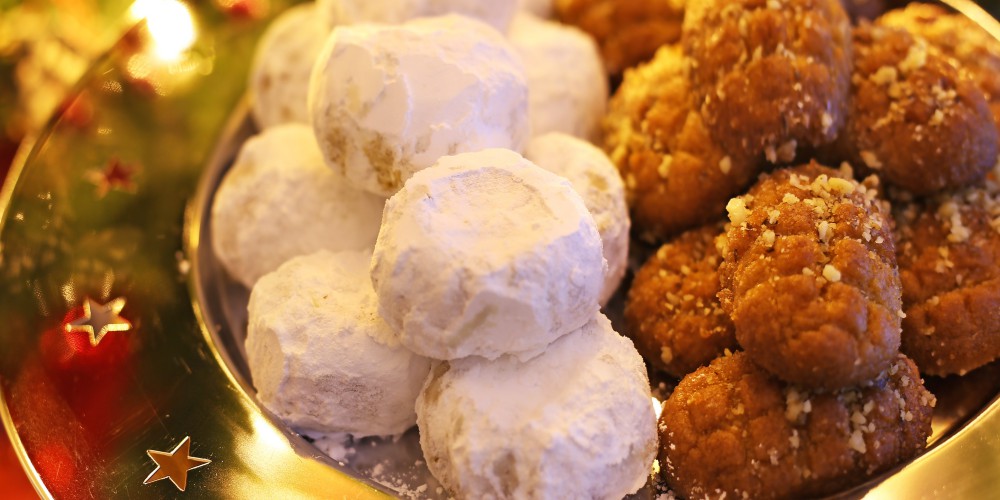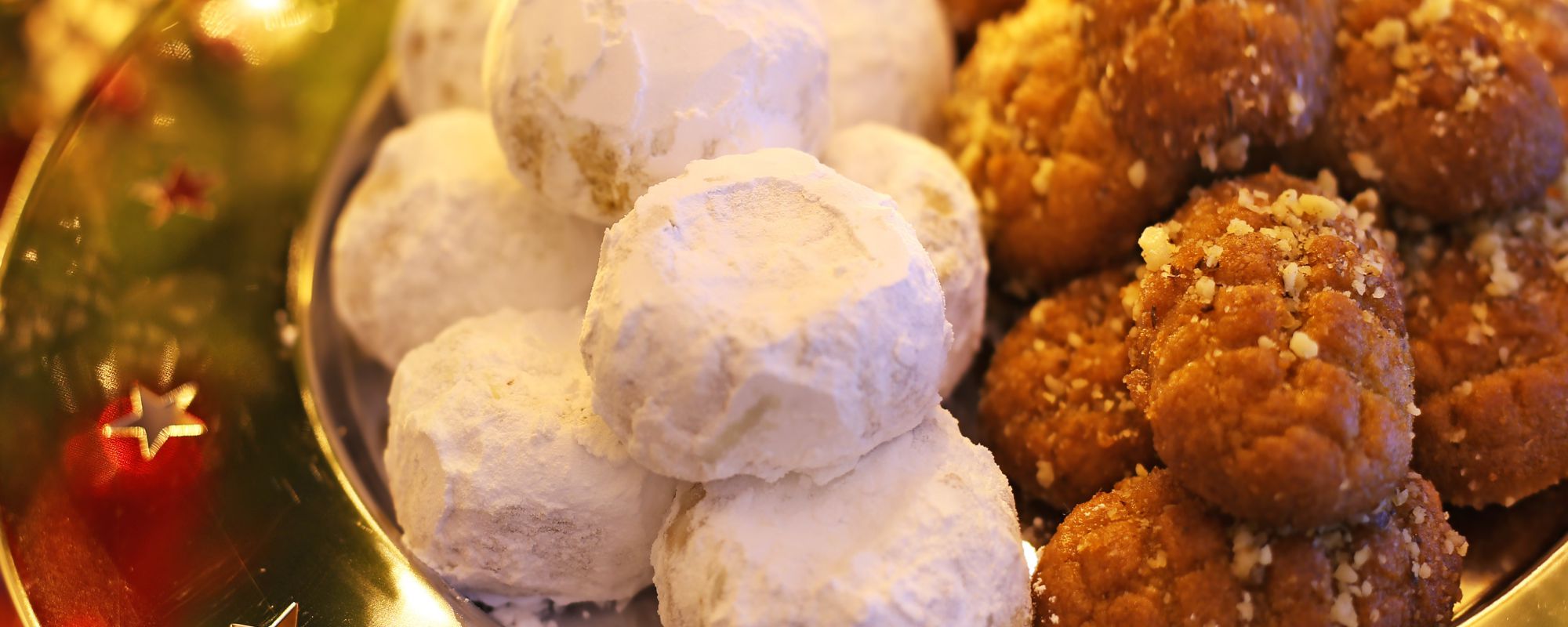
A Guide to Greek Christmas Treats
Key Takeaways
- The traditional Greek Christmas treats are not only delicious but also carry cultural significance, bringing families and communities together during the holiday season.
- Melomakarona are traditional Greek Christmas cookies made with a combination of olive oil, honey, flour, and spices such as cinnamon and cloves.
- Kourabiedes are another popular Greek Christmas treat. They are buttery shortbread cookies dusted with powdered sugar.
- Vasilopita is a special cake, or sweet bread, that is prepared on New Year's Day to celebrate St. Basil's Day.
Who doesn’t want an excuse to stuff their face with delicious treats? And what could possibly be a better excuse than Christmas?
Greece is known for its magnificent food, and the festive season presents itself as another opportunity to explore the Greek cuisine that is guaranteed to -once again- impress you.
Even the Greek orthodox church agrees!
Here you will find the list of our favorite Christmas treats that you should absolutely try next to the Christmas trees (or Christmas boats) and cute Christmas decorations while visiting Greece during Christmas!
Kourabiedes: The "Snow-Covered" Cuffs
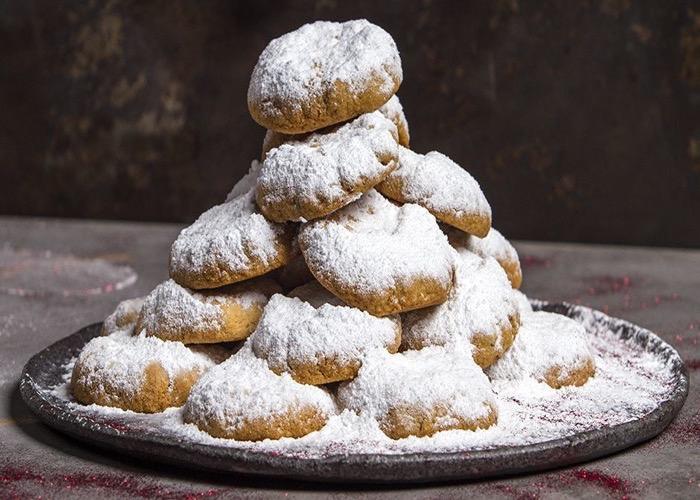
Kourabiedes are sweet Christmas cookies made from toast, butter, and almonds, all sprinkled with powdered sugar that goes hand-in-hand with Greek Christmas carols on Christmas Day and Christmas Eve.
These traditional Greek sweets that characterize Christmas in Greece are said to have originated from Persia (first appearing in the 7th century when sugar was brought to the region) and are widespread in Greece, Turkey, and the rest of the Balkan countries.
Analyzing the Turkish word 'kurabiye,' its roots can be found in the words kuru, which means dry, and 'biye' which is a loan from the Latin word for 'biscuit.'
Biscuits are produced through a method of double baking, which has been in practice since ancient times. This allows for excess moisture to be expelled, which therefore makes the biscuit last even longer.
The Greek kourabiedes are quite similar to the Scottish shortbread in taste and are one part sugar, two parts butter, and three parts flour.
The oriental origin of kourabiedes, however, requires sheep and goat butter along with almonds, which makes it particularly distinct from the European cookies of the same family.
Although kourabiedes may not be the healthiest of the options, they are loved by many due to their rich taste and unique, crumbly texture.
We may not leave milk and cookies for our Greek Santa Claus next to the Christmas tree, but if we did, kourabiedes would be our "biscuit" of choice!
Melomakarona: The Sticky Goodness
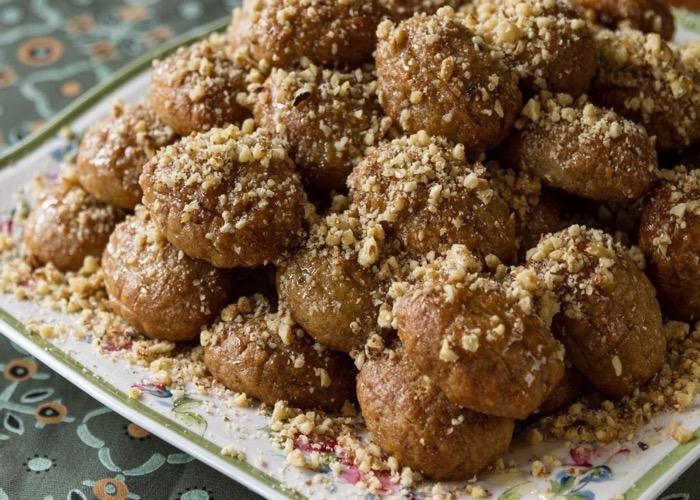
This sticky goodness was, is, and always will be our favorite Christmas treat. The taste of melomakarona is directly connected to the joy of Christmas in Greece.
However, their past is quite unexpectedly morbid. A Greek pastry made mainly from flour, semolina, olive oil, orange juice, and honey, it is one of the healthier options as it is the lowest in calories.
Melomakarona, along with kourabiedes are a must according to Greek Christmas traditions that are considered indispensable in every home, mainly during the Christmas period, and in English, this sweet treat can be found under the name of the small honey cake.
Although the first thought that comes to mind is the Italian word macaroni, the name melomakarona actually comes from ancient Greece!
Specifically, macaroni comes from the ancient Greek word 'macarias', which was a piece of bread in the shape of the modern melomakarona, which was offered after funerals.
Later, the bread was dipped in honey syrup, got renamed melomakarono, and established as a 12-day confection.
The Latins and, later the Italians used the word 'macarone' as 'maccarone,' which eventually meant spaghetti.
Finally, in France and England, a kind of almond biscuit was called macaroon (the well-known macaron). Putting their morbid history aside, the modern melomakarona are healthy and unique Christmas treats that everyone should try!
Diples: Greek Christmas Tradition Doused in Honey
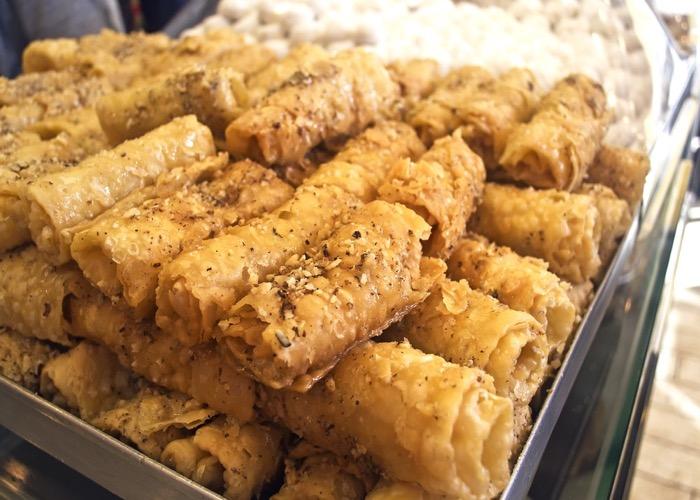
Diples (which can be translated as folds) is a Greek Christmas dessert, believed to come from the Peloponnese, in which the main ingredient is thin dough.
Not impressive, is it? Well, the thin dough may not be the most impressive of ingredients; diples, however, are arguably one of the most delicious and traditional Christmas sweets Greece has to offer.
The dough is folded into various shapes, fried in hot oil, doused in syrup or, more traditionally, honey, and finally sprinkled with cinnamon and chopped nuts.
The folds can have various shapes, but they are most commonly shaped like spirals, bowls, and flowers.
Diples are usually served on New Year's Eve, but sometimes they are offered at weddings as well! The folds of diples are said to symbolize the infancy of Christ, while honey symbolizes the welfare and creativity that we want the New Year to bring us.
Xerotigana: The Cretan Diples
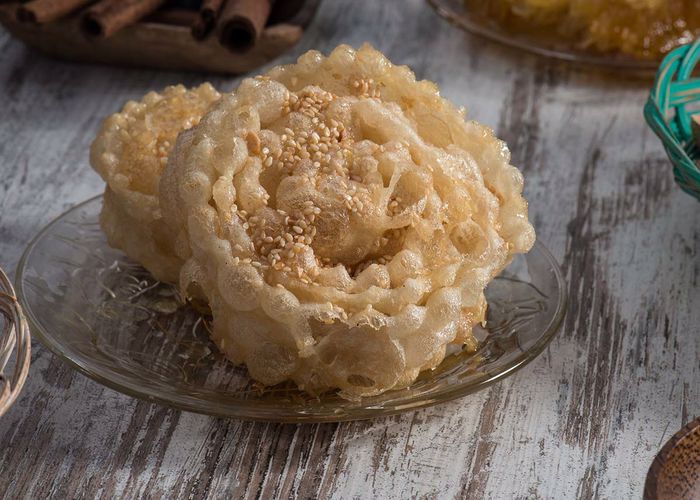 Xerotigano - credits: meli-ladi.gr
Xerotigano - credits: meli-ladi.gr
However, if you are visiting Crete during Christmas, then you may as well try the Cretan recipe of Diples, Xerotigana.
Despite the only difference lies in the shape and the folding of the dough, which requires a lot of skill and experience, Cretans take great pride in their version of the Christmas dessert.
As they should, this crispy, syrupy fried dough, sprinkled with walnuts, sesame seeds, and cinnamon, makes the perfect Christmas delicacy.
Lalagia: A Christmas Treat From Mani
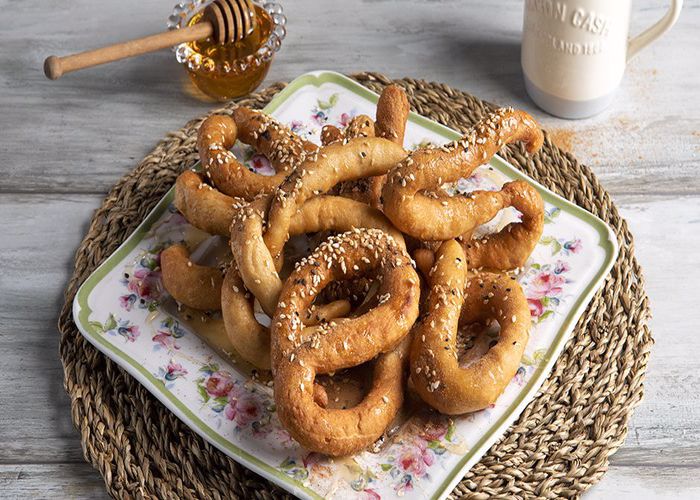 Lalagia - credits: akispetretzikis.com
Lalagia - credits: akispetretzikis.com
Considering that the Peloponnese is a magical peninsula in Southern Greece, filled with local villages to uphold traditions and Christmas customs, it is only natural to present a unique Christmas treat for you to try.
In mainland Greece, and specifically the Mani and Messinia regions, Lalagia is a must during the Christmas season.
Much like loukoumades, Lalagia will remind you of a Greek version of donuts since they are oval-shaped fried dough, served either sweet or savory, with feta cheese!
The traditional Christmas version is the one where the fried dough is sprinkled with honey and walnuts or powdered sugar.
Klostari
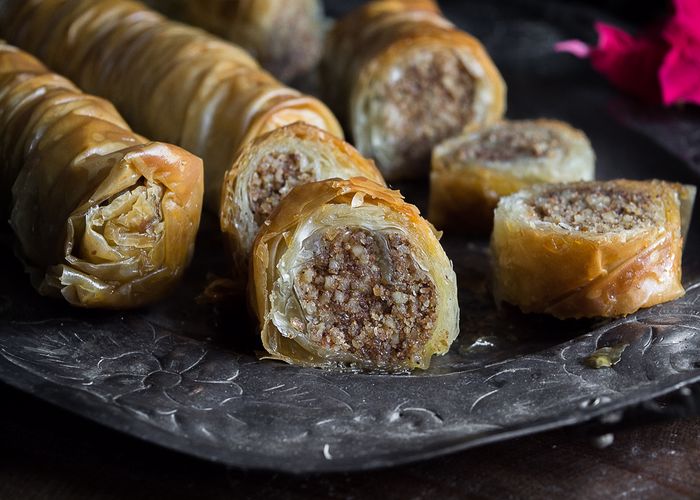 Klostari - credits: passenger.gr
Klostari - credits: passenger.gr
You’ve probably heard of Baklavas before, a traditional Greek dessert much loved ever since the Ottoman Empire, but did you know that in the Epirus region, there’s a festive version of Baklavas, so they can celebrate Christmas in the sweetest way possible?
Klostari, as this traditional Christmas treat is called, is made with a crust sheet and filled with plenty of grated walnuts, honey, and cinnamon. Its name comes from the way it is made, as the walnut filling and the sheets are "spun" and strained like a thread.
If you find yourself in the beautiful city of Ioannina, you should definitely try it.
The New Year’s First Taste: Vasilopita
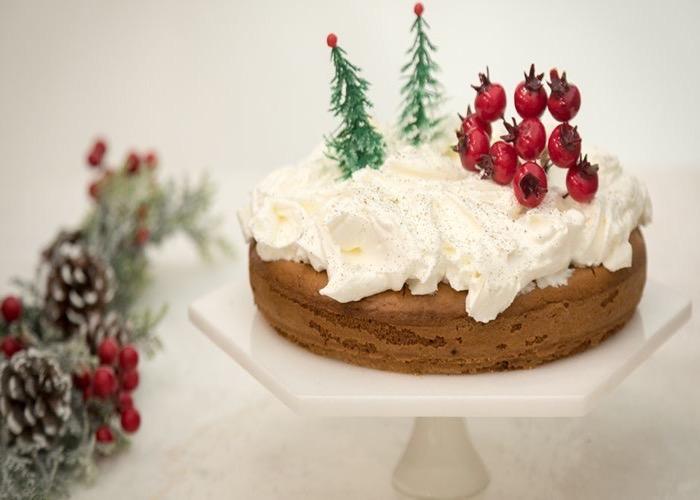
Vasilopita is the pie made in some, mostly Christian, countries on New Year’s Eve and is cut shortly after the year changes.
As it is the first thing we taste, it is very important to be as good as we want the whole of the following year to be.
In Athens, it is made mainly of flour, eggs, sugar, and milk. It can come in various sizes and types but is usually fluffy and sweet.
In Western Macedonia, vasilopita is often made with cheese or even parsley. Also, on the vasilopita, the New Year's number is often written with either some type of marmalade, rows of peeled almonds, or powdered sugar.
Regardless of whether they are sweet or savory, they all have one thing in common: an unusual New Year’s Eve custom according to which, inside the pie, one should place a gold or silver coin.
With the coming of the New Year, the mother of the family cuts the pie into triangles; a slice is then offered to each person except for three pieces which are dedicated to Christ, the Virgin & the home.
These slices are then eaten on the following days. The one who finds the hidden coin in their piece is believed to be rewarded with good luck for the rest of the New Year!
Fun Facts About Greek Christmas Treats
- Greek Christmas treats often incorporate ingredients like honey, nuts, and spices, reflecting the country's rich culinary heritage and use of local produce.
- Many Greek Christmas treats have symbolic significance, representing themes such as prosperity, good luck, and unity within the family.
- In Greece, the Christmas season is a time for sharing and hospitality, with families and communities coming together to prepare and enjoy traditional treats.
- Some Greek Christmas treats have ancient roots, dating back to pagan festivals and religious ceremonies, which have evolved over time to become part of modern holiday traditions.
- Greek families often have their own unique recipes and variations for Christmas treats, passed down through generations and cherished as part of their cultural heritage.
- The preparation of Greek Christmas treats is often a labor of love, with families spending hours in the kitchen baking and cooking together, creating memories and traditions that last a lifetime.
- During the Christmas season, Greek bakeries and markets are filled with a wide variety of traditional treats, offering a taste of nostalgia and a reminder of the joyous spirit of the holidays.
- Greek Christmas treats are not only enjoyed within the country but are also shared with friends and loved ones as gifts, symbolizing friendship, goodwill, and the spirit of giving.
- Some Greek Christmas treats have regional variations, with different parts of the country having their own unique specialties and recipes, adding to the diversity and richness of the culinary landscape.
- While Greek Christmas treats are enjoyed during the holiday season, many are also eaten throughout the year, serving as a delicious reminder of the festive cheer and traditions that accompany this special time of year.
Final Thoughts
You would be lying if you claimed that all this talk about Christmas treats hasn't left you craving all the Christmas goodies you can find. We apologize in advance for having wrecked your diet.
However, we do not apologize for the opportunity that we gave you to get to know the Christmas treats of Greece because the Greek Christmas experience cannot be considered complete without them.
Remember, Greece isn’t just sunny days, endless beaches, and picturesque Greek islands! Figure out all the reasons why you will visit Greece in winter and fall in love with Greece in the off-season!








